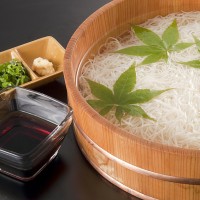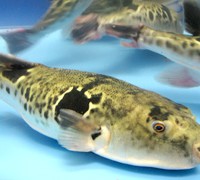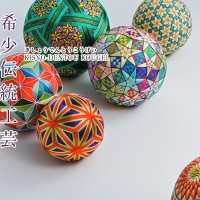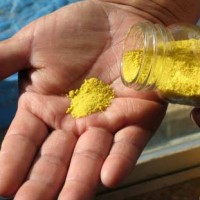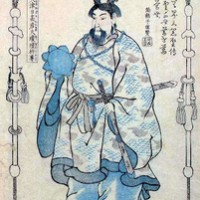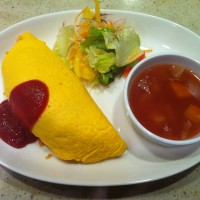Monthly Archives: July 2015
Thursday: Japanese Food (日本の食べ物)
07/24/2015 blog
Soomen (そうめん) and Zarusoba (ざるそば) Popular Summer Dish – Noodle Soomen: <https://en.wikipedia.org/wiki/S%C5%8Dmen> (Typical Soomen Noodle Served Cold in Summer) Soomen (素麺/そうめん) is a name of the kind of very thin noodle, but the dish itself is called Soomen. No Japanese has Soomen in winter. This is definately a summer item, which is cooked at home or served at traditional Japanese restaurants. Usually, it is made of flour and its color is white like the one in the picture above. At table, Soomen is served with special dipping sauce called Soomen Tsuyu (つゆ). Since Soomen noodle is so simple, people tend to add some additional flavor mixed with the needle itself or …
Thursday: Japanese Food (日本の食べ物)
07/23/2015 blog
Fugu (ふぐ)/Pufferfish <https://en.wikipedia.org/wiki/Fugu> (Fugu swimming in a tank – Ready to be cooked) (Fugu chopped up to be served as individual menus) (Sashimi/Sliced Fugu Meat called Tessa) (Fugu Hotpot called Tecchiri) (Deepfried Fugu called Fugu Karaage) (Grilled Row with Salt called Shirako) (Pickled Fugu Skin called Fugu Kawa) As you may know it, some parts of Fugu (ふぐ) contain high amount of toxin, you need to get a license to cook Fugu in Japan. As a matter of fact, a fair number of people get killed because of Fugu poison every year. I strongly recommend you should eat Fugu cuisines cooked only by professionals with particular license. Fugu cuisines are seasonal. …
Wednesday: Nihon-no Manga (日本の漫画)
07/22/2015 blog
Tensai Bakabon (天才バカボン) (https://en.wikipedia.org/wiki/Tensai_Bakabon) This is the most nonsense manga (まんが)/cartoon in the world! “Tensai Bakabon (てんさいバカボン)” appeared in one of the most popular boys’ magazines in 1967. A TV show called “Tensai Bazkabon” started in 1971 and lasted for such a long time, including reruns, that the boys who watched those episodes grew up to watch a new series of “Tensai Bakabon” with his sons. Girls, who tend to be maturer and more rational than boys, didn’t like this original manga or TV show very much. This manga is all about one special family of four – Bakabon (an older son of this family), Hajime (a …
Tuesday: Nihon-no Kotowaza
07/21/2015 blog
Tatsu Tori Ato-wo Nigosazu (立つ鳥跡を濁さず) [Vocaburary] Tatsu (立つ/たつ): Leaving Tori (鳥/とり): Birds Ato (跡/あと): Marks; Traces; Evidence Nigosazu (濁さず/にごさず): Not soiling; Not leaving stains behind [Literal Translation] Even birds clean up their mess before they leave. [Translation] It is an ill bird that fouls its own nest. [Comment] In Japanese, the word, Tatsu (Leaving), can be interpreted in many ways, such as “taking off,” “start out new,” “moving to another job or place,” “leaving this world,” and so on. So, this proverb teaches you to “clean up the mess you made so you wouldn’t look back and regret about it before you leave.” Very traditional Japanese way to live.
Tuesday: Nihon-no Kotowaza
07/21/2015 blog
Goo-ni Ittewa Goo-ni Shitagae (「郷に入っては郷に従え」) [Vocaburary] Goo (郷/ごう): the country; a district; a village Ittewa > Iru (入っては/いっては): When you are in ~ Shitagae (従え/したがえ): observe; obey; abide by; conform to; act upon [Translation] When you are at [in] Rome, do as Rome does [the Romans do].
Monday: One Point Nihongo Clinic
07/21/2015 blog
A Generic Counting Sequence (てまり/Temari) 一つ(ひとつ)Hitotsu 二つ(ふたつ)Futatsu 三つ(みっつ)Mittsu 四つ(よっつ)Yottsu 五つ(いつつ)Itsutsu 六つ(むっつ)Muttsu 七つ(ななつ)Nanatsu 八つ(やっつ)Yattsu 九つ(ここのつ)Kokonotsu 十(とお)Too <Example> You: “Oikutsu (desuka)? 「おいくつ(ですか)。」” A 7-years-old: “Nanatsu (desu). 「ななつ(です)。」” (How to make Temari: https://youtu.be/6vAIrSJBSo0)
Monday: One Point Nihongo Clinic
07/20/2015 blog
“Ko (こ),” “So (そ),” “A (あ),” “Do (ど)” #3 Special uses of “So (「そう」)” (“Oh, yeah!” Dance) [Situation: You are in a grocery store.] When you get to the Bakery section, you saw dozens of bagels taken out of the oven. “Smells yummy!” All of sudden, you remember your favorite cream sheese is running out. You: “Oh, yeah! I got to get my cream cheese at Dairy section!” When you have a sudden idea or recollection like “Oh, yeah!” in English, you say “A, So da (「あっ、そうだ!」)” in Japanese. Other expressions applicable to this Japanese translation includes “Oh, I know!” and “Oh, that’s right.”
Saturday (NEW): ナバホインディアンのくにへ #3
07/19/2015 blog
<つづき> よる、わたしは、ホーガン(おもやとつながっている)にねたのであるが、しゅうしんまえ、スティーブがこのホーガンをおとづれ、このでんとうてきたてもののせつめいをしてくれた。とうざいなんぼくにもそれぞれつぎのようないみがあるという。 ひがし:いりぐち (このルールはぜったいにまもらなければならない) みなみ:こども にし:おとこ きた:おんな (じゅうようなものはここにおく) また、ひがしとにしはおのおの「さいしょのおとこ」と「さいしょのおんな」のほうがくであり、みなみは「ちしき」を、にしは「りかい」を、きたは「しんねん・しんこう」をあらわしているのだという。 にんげんのりょうあしで、みぎあしは「おんな」で、ひだりあしは「おとこ」、そのあいだのくうかん(あな)はいりぐちで、ここからペニスがそうにゅうされ、こどもができる。ホーガンのかたちは、にんしんちゅうのおんなのはらをあらわし、そのちゅうしんでもえているだんろは、おんなのはらのなかでじゅせいがおこなわれるさま、もえているひは、しゃせいごのおんなのはらのなかのようすなのだそうだ。
Saturday (NEW): ナバホインディアンのくにへ #2
07/19/2015 blog
1がつ30にち (とうもろこしのかふん) スティーブはメディスンマンである。だから、グレイスとさいかいしたときも、なにかこなじょうのものをかのじょのくちにいれ、いのりをとなえていた。そのあと、グレイスとはわかれ、スティーブのくるまでかれのいえへとむかう。かれのオフィスはニューメキシコしゅうのギャラップというところにある。ここから、ウインドウロック(アリゾナしゅう。ナバホぞくほりゅうちないのちゅうしんち。ぶぞくせいふもここにある。)までは30~40ぷんといったところか。そこからさらに、かれのいえのあるフォートディファイアンスまで10ぷんほどかかる(ギャラップーウインドウロックかんは44マイル、いっぽうウインドウロックーフォートディファイアンスかんは5マイル。)。 しゃちゅう、スティーブは、「じぶんにはショショニぞくのじょせいとのりこんれきがあり、かのじょとのあいだにせいじんしたむすこがいる」こと、「げんざいのつまはかれとおなじくナバホぞくしゅっしんだが、かなりとしした(ちょしゃとおないどし)で、かのじょとのあいだにはしょうがくせいのおとこのこふたりと、まだ1さいにならないあかんぼうがいる」こと、「ふだんかのじょとこどもたちは、ここからにしへ180マイルはなれたフラッグスタッフにすんでおり、しゅうまつにはスティーブはそこへかえるので、るすばん(ちょしゃのやくめ)がいる」こと、「もうひとり、だんせいのげしゅくにん(ナバホぞくしゅっしん)がいるが、かれはこのたびあたらしくぶぞくせいふでしょくをえて、いまじゅうきょをさがしているので、みつかりしだいでていくし、かれとてほかにかぞくがいるのでしゅうまつにはそこへかえる」ということなどをかいつまんではなしてくれた。
Saturday (NEW): ナバホインディアンのくにへ #1
07/18/2015 blog
Ya’at’eeh (「こんにちは」in Navajo) 1995ねん しょしゅん みわたすかぎりいちめんのゆきー。 とうとうわたしは、ゆうじんのグレイス(ナバホじょせい)のつてをたどり、このナバホほりゅうちにやってきた。ゆきもゆきだが、まさしくなにもないところでかんさんとしている。グレイスのいもうと、グロリアのじょうしで、ほりゅうちないにすんでいるスティーブというちゅうねんナバホだんせいのいえにげしゅくすることになる。わたしの「ナバホかんさつにっき」はここからはじまる。
Friday: Kojiki (「乞食」ではなく『古事記』ですヨ!!) #21
07/17/2015 blog
Tenson Koorin (てんそんこうりん) <The Advent of the Sun-Goddess’s Grandson> (Ninigi-no Mikoto: Sun-Goddess’s Grandson) (Takachiho – The Place where Ninigi descended) (Takachiho Shrine) At last, Ninigi-no Mikoto (ににぎのみこと), Sun-Goddess’s Grandson, left his Imperial throne in Takamagahara (たかまがはら) and travelled through piled up clouds to get to Takachiho (たかちほ). Ame-no Oshihi-no Mikoto (あめのおしひのみこと) and Amatsukume-no Mikoto (あまつくめのみこと) were in the van of a procession to serve Ninigi with Ame-no Iwayuki (あめのいわゆき: baskets for sacred arrows), Kubutsuchi-no Tachi (くぶつちのたち: sacred swards), and Ame-no Hajiyumi (あめのはじゆみ: sacred arrows). Ame-no Oshihi-no Mikoto would become an ancestor of Ootomo-no Muraji (おおとものむらじ: the family in charge of military units) and Amatsukume-no Mikoto would be an ancestor of …
Thursday: Japanese Food (日本の食べ物)
07/16/2015 blog
Omurice (オムライス) Omulet + Rice (Fried Rice with Ketchup) Like other popular dishes among Japanese kids such as Curry and Udon/Rice, this item called Omurice (Omlet + Rice with Ketchup) is one of Japanese kids’ most favorite dinner menus! Simply enough, rice, chicken, onion, and couple of more ingredients are fried in a frying pan with Ketchup, which is wrapped with a thinly fried eggs. Other than traditional style of this kind, you will see a lot of variations nowadays! I cooked this prototype, and failed…. My kids didn’t like the idea of eating fried rice with ketchup…. To American kids, it was too much for them to …
Wednesday: Nihon-no Manga (日本の漫画)
07/15/2015 blog
Tonari-no Totoro (となりのトトロ) (Totoro – Creation By Hayao Miyazaki and Studio Ghibli) This was released in 1988, winning a lot of film prizes inside and outside Japan. Hayao Miyazaki created this “unique character” in film without no original printed cartoons. He is such a genius that he took full advantage of this opportunity. Not all of his works are my favorites, but I do love “My Neighbor Totoro (となりのトトロ).” It’s definitely a tearjerker, depicting the Japanese cultural aspects most Japanese miss in the situation of “Post War Period.” Even if you know nothing about the WWII, you can connect your feelings and emotion and to this particular Japanese film of …
Tuesday: Nihon-no Kotowaza
07/14/2015 blog
Warau Kado-niwa Fuku Kitaru (「わらうかどにはふくきたる」) Fortune comes to a merry home. [Vocaburary] Warau: Laugh or Smile Kado: Entrance, which means “Household” Fuku: Luck or Happiness Kitaru: Same as “Kuru” – Come <RULE FIVE … for a Better Way to Live> Build this day on a foundation of pleasant thoughts. Never fret at any imperfections that you fear may impede your progress. Remind yourself, as often as necessary, that you are a creature of God and have the power to achieve any dream by lifting up your thoughts. You can fly when you decide that you can. Never consider defeat again. Let the vision in your heart be in your life’s …
Monday: One Point Nihongo Clinic
07/13/2015 blog
“Ko (こ),” “So (そ),” “A (あ),” “Do (ど)” #2 Special uses of “So (「そう」)” (Diagnosis of Cancer) For the last couple of months, you’ve never felt well. You don’t think you enjoy your life. You think you are smiling, but nobody can tell you are. You have also noticed there are some unusal symptoms in your system. You have no idea what is going on. Your spouse finally suggested you go see your doctor, which you did. Your doctor recommended that you would go through a complete check up and following painful examinations. One morning, you got a phone call from your doctor’s office and her office rep told you to …

